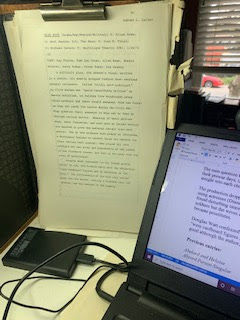 |
| Ray Thorne, Tom Lee Jones, Diane Kagan, Allan Knee, Robert Stattel, Jerry Dodge, Ann Sweeny. |
"In Lieu of Review"
For background on how this previously
unpublished series—introducing all mainstream New York shows between 1970 and
1975—came to be and its relationship to my three The Encyclopedia of the New York Stage volumes (covering every New
York play, musical, revue, and revival between 1920 and 1950), please check the
prefaces to any of the earlier entries beginning with the letter “A.” See the
list at the end of the current entry.
BLUE BOYS [Drama/Military/Period/War] A: Allan Knee; D:
Neal Kenyon; S/L: Tom Munn; C: Joan E. Thiel; P: Michael Carson; T: Martinique
Theatre (OB) 11/29/72 (1)
A difficult play, the author’s first, Blue Boys was written in a subtle, not easily grasped fashion that
confused several reviewers. Called “wildly self-indulgent” by Clive Barnes but “quite
beautifully written” by Martin Gottfried, it takes place during the Civil War
and follows five frightened young Union soldiers and their stupid sergeant (Tom
Lee Jones) as they prepare for battle. Despite the presence of future star Jones,
whose first name later morphed into Tommy, Blue
Boys was here and gone in a single night………………..
The men question their purposes in this the war as they go
through various drills. Memories of their prewar days, their fantasies, and
such acts as letter writing are offered to give the audience insight into each
character.
The production dropped a tiny seed into the incipient movement
toward cross-gender casting by using actresses (Diane Kagan, Ann Sweeny) to
play two of the soldiers, a feature several critics found disturbing since the
reasons for such casting were unclear. The women played not only soldiers but
the wives and sweethearts of the men in flashback scenes. Late in the action,
they became prostitutes.
Douglas Watt confessed “it all looked pretty silly” to him, and
Richard Watts said the characters “were cardboard figures and as bloodless as
the . . . play.” The performances, on the whole, were good although the author,
playing a 19-year-old soldier, was the weakest in the company.
Previous entries:
Abelard and
Heloise
Absurd Person
Singular
AC/DC
“Acrobats”
and “Line”
The Advertisement/
All My Sons
All Over
All Over Town
All the Girls Came
Out to Play
Alpha Beta
L’Amante Anglais
Ambassador
American Gothics
Amphitryon
And Miss Reardon
Drinks a Little
And They Put
Handcuffs on the Flowers
And Whose Little
Boy Are You?
Anna K.
Anne of Green
Gables
Antigone
Antiques
Any Resemblance to Persons Living or Dead
Applause
Ari
As You Like It
Augusta
The Au Pair Man
Baba Goya [Nourish the Beast]
The Ballad of Johnny Pot
Barbary Shore
The Bar that Never Closes
The Basic Training oAf Pavlo Hummel
The Beauty Part
The Beggar’s Opera
Behold! Cometh the Vanderkellens
Be Kind to People Week
Berlin to Broadway with Kurt Weill
Bette Midler’s Clams on a Half-Shell Revue
Black Girl
Black Light Theatre of Prague
Black Picture Show
Black Sunlight
The Black Terror
Black Visions
Les Blancs
Blasts and Bravos: An Evening with H,L.
Mencken
Blood
